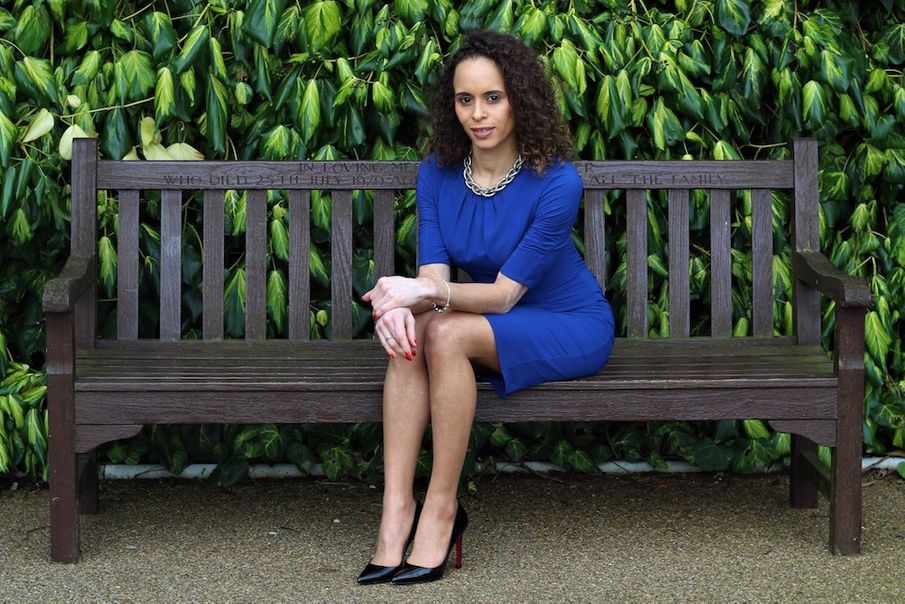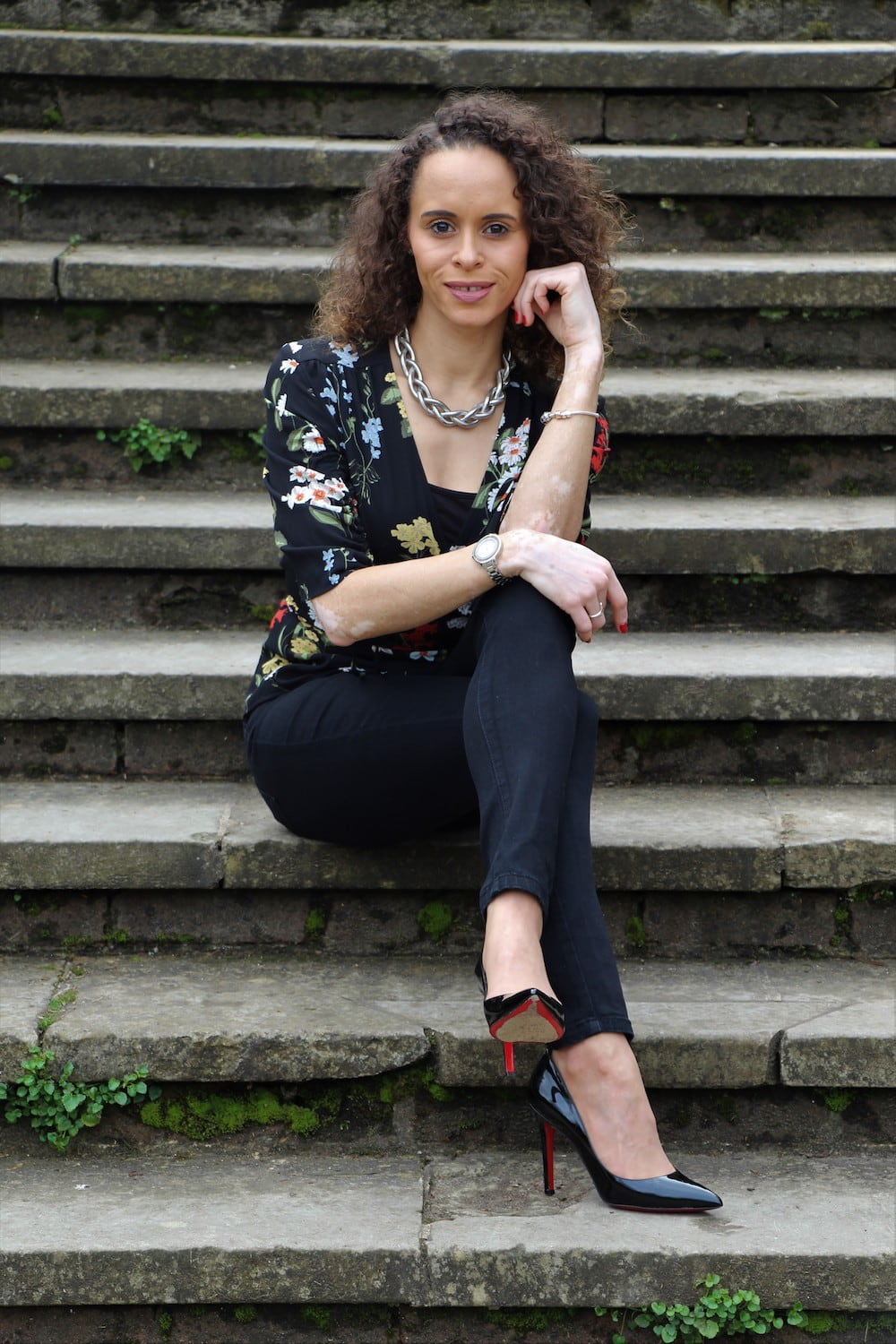Having spent her life coming to terms with the skin condition vitiligo, Natalie Ambersley discovered a new type of treatment that transformed her confidence in herself, and her appreciation for the story her skin reveals
In 1984, at just two years old, I developed vitiligo – a long-term skin condition where white skin cells stop making pigment, causing white patches to form on the skin.
At first, it started rather innocently as a small patch on the back of my hand, no bigger than a five pence piece. However, by the time I was four years old, the patches had spread, turning my once caramel-coloured skin 70% white.
Soon after diagnosis, my parents began their search for a cure, with endless trips to Great Ormond Street Hospital, London, quickly becoming the norm. Being so young, I had no idea that I was different, or what having this skin condition would mean for me later in life.
In the early stages, my parents were advised on all the treatment options, which weren’t many for someone my age. We started with a highly potent steroid cream, then homeopathy, Chinese herbal medicine, patient trials and altering my diet. As long as it was safe, anything was worth a try.

To try to find the root cause, I had to have blood tests to check my thyroid, which would leave me screaming and blubbering because I was terrified of needles. My mum would grip me tightly, her hands pressed over my eyes, so that I didn’t look. It was a traumatic ordeal, not just for me, but for my parents as well.
Despite all this, growing up I was a happy child. My parents refused to hide me away, ensuring I wore dresses to school, and shorts and T-shirts during the summer. They were adamant that I wouldn’t grow up thinking I was different. Of course people stared, some implying that my mum had left me to burn in a fire, but she mostly dealt with ignorance by explaining it or ignoring them.
My skin was the first thing children would target if they wanted to hurt me. Certain kids would refrain from touching me from fear they would catch it, or tell me that my skin resembled a cow or a zebra. I learned to be resilient to the occasional jibe, but it still hurt and quickly made me question why I didn’t look the same as everyone else.
Soon after my 12th birthday, my parents decided to abandon all forms of treatment. I had given up on ever being cured, and was frustrated with the endless trips to the hospital that were proving to be a waste of time. When they told me I wouldn’t have to go anymore, I was relieved.
Vitiligo only really became an issue during my teens. Alongside dealing with the usual pressures, I had my unpredictable skin condition to deal with. My friends would say: “It’s not that bad.” I desperately wanted to believe them, but couldn’t see past the patches on my skin. My confidence and self-esteem dived, and I gradually became insecure with who I was.
I’m not sure what triggered the idea of treatment again, 15 years later, but I recall seeing threads about UVB Narrowband – a type of light treatment – on social media and the Vitiligo Society. The reviews were very mixed though. For some it had helped them regain a significant amount of pigment in their skin, while others were left disappointed. Nevertheless, I was curious and wanted to find out whether my case was severe enough to warrant a referral to the hospital.
Two weeks later, after visiting my GP, I left with the letter I needed to start the treatment.
I sat in the hospital waiting room anxiously anticipating the dermatologist’s arrival. When she did, she began shading the areas where I was affected onto a figure on a piece of paper. Knowing my body for as long as I have, even I was shocked to see just how much vitiligo had invaded it. I knew I had made the right decision.
The potential risks did make me nervous though – itchy skin, a chance my vitiligo could worsen, and the possibility my skin would burn under the light. Worst of all, there was a 1% chance of skin cancer, which terrified me.
Family and friends were supportive of my decision, and understood my frustrations as a woman with vitiligo. All of them apart from one friend, that is, who was horrified that I wanted to drastically change. “Why are you trying to change who you are?” she asked. “Your skin is fine as it is, because it’s what makes you, you.”
I didn’t see what she saw though. All I saw was someone who had placed restrictions on her life because of her skin, and I’d had enough.
I pushed the risks to the back of my mind every time I stepped inside the UV cabinet, which was essentially an upright tanning booth. Naked and with the door closed, the timer would be set to a few seconds, gradually building up to minutes as my body got used to the routine.
On treatment days, I couldn’t wear jewellery, makeup, moisturiser or perfume because they contain ingredients sensitive to light, which could cause burning. That would make for an anxious journey to the hospital, with my makeup-free face exposed for all to see.
In the first few months, I refused to leave the house without makeup on, so I applied before I left home and removed it when I arrived at the hospital. A complete waste of time, waste of makeup, and to top it all, the nurses would often tell me off for it! Eventually, as I cared less about what people thought, I left home makeup-free, with the breeze touching my natural face. It felt so invigorating.
But the good news is that I began seeing the pigmentation return to my skin after three months. I’d observe my skin every night, getting excited when I noticed another new patch of brown appearing. It felt like a miracle was unravelling before my eyes.
I was relieved when I was officially discharged from the hospital 14 months later. My skin had miraculously repigmented, reducing my white patches down to around 30%. I couldn’t believe how different I looked with the skin colour I had been born with.
Soon after, I experienced my first beach holiday. I can’t explain the excitement I felt as I shopped for new swimwear and clothes that allowed me to show off my skin. I felt like a new person.
I still have vitiligo on my body. My hands are the worst – bright white with random brown spots – and I have patches on my arms and legs. The only difference now is that I’ve learnt to accept my skin because it’s part of the story that makes me who I am. While I did embark on a journey of treatment to try and erase my past, I’m glad some of it still remains, because without vitiligo I wouldn’t have been who I was then – and especially not now.
Natalie is a blogger who shares her journey with vitiligo at beingjustus.co.uk. To learn more about the condition, please visit: vitiligosociety.org.uk
Natalie’s story is one of perseverance, strength, and hope. Her supportive parents ensured she had a happy childhood, despite having to deal with others’ cruel words. As she grew older though, the idea of “being different” affected her self-confidence. Many of us will identify with the feeling of not fitting in. What Natalie realised was that it was how she saw herself that mattered, not the perceptions of others. With an open mind, she was brave enough to try a new treatment. Natalie reminds us that we can all be happy in our own skin!




Comments